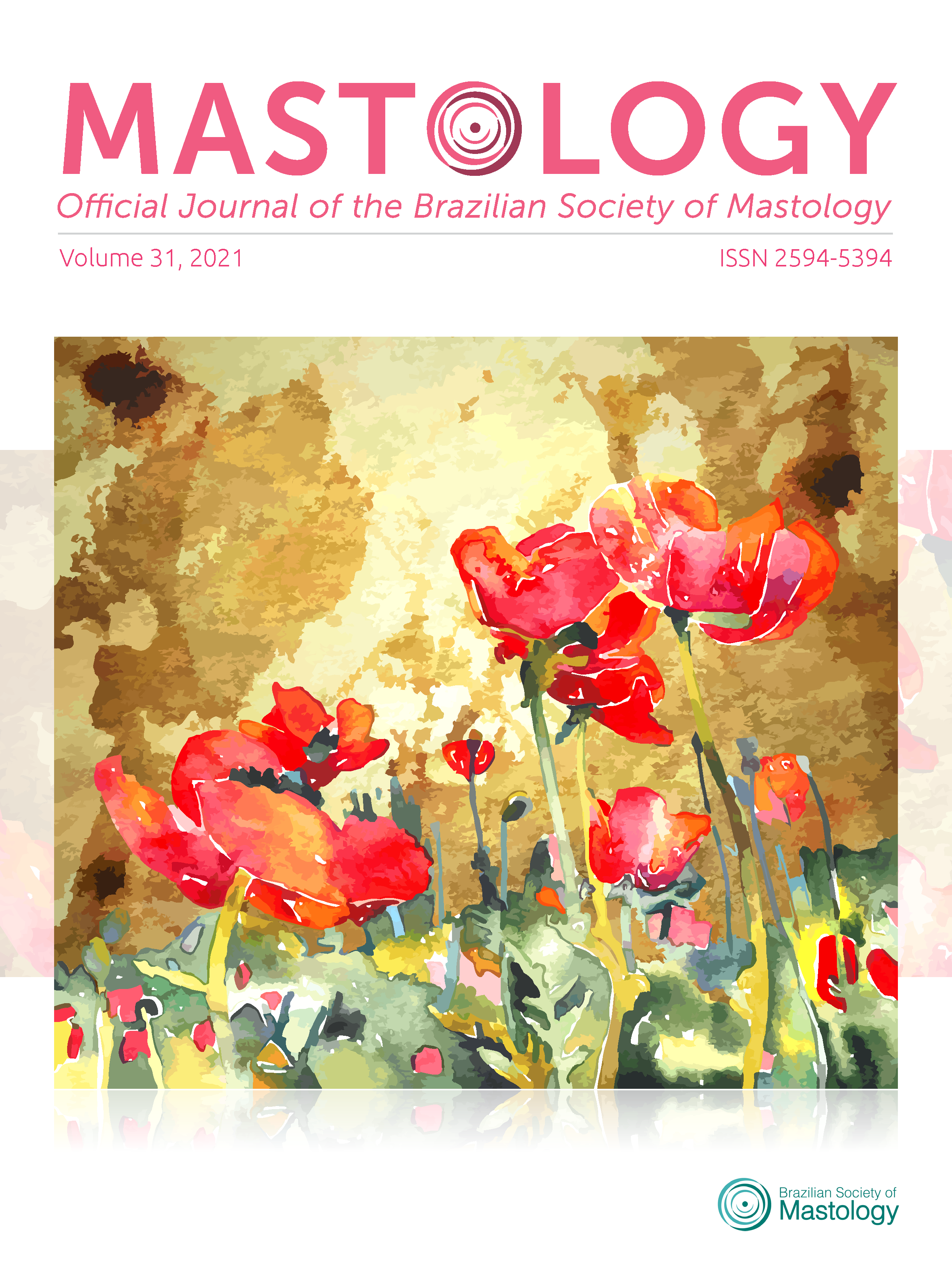Evaluation of clinical and pathological response factors to neoadjuvant chemotherapy in breast cancer patients
Keywords:
breast neoplasms, neoadjuvant therapy, molecular biology, residual volumeAbstract
Objectives: To evaluate breast cancer (BC) patients treated with neoadjuvant chemotherapy (NACT) and to analyze clinicopathological features correlating with pathological complete response (PCR) and survival outcomes. Methods: Observational, descriptive, and retrospective study. The medical records of BC patients who underwent NACT were reviewed and analyzed using the Statistical Package for the Social Sciences (SPSS), version 20.0. Results: Of the 176 BC patints who underwent NACT, 62 patients (35.2%) achieved PCR. The PCR rate was 22% (n = 2) for luminal A, 15% (n = 9) for luminal B/HER2-negative, 45.5% (n = 15) for luminal B/ HER2-positive, 50% (n = 14) for non-luminal/HER2-positive, and 47.8% (n = 22) for triple-negative (p = 0.01). Histological grade, estrogen receptor (ER) expression, progesterone receptor (PR) expression, and HER2 status were significantly associated with PCR (p = 0.022, p = 0.01, p = 0.01, and p = 0.02, respectively). The median follow-up was 35.9 months, the estimated 5-year disease-free survival (DFS) was 96.7% in the PCR group and 83.2% in the non-PCR group (p = 0.05). The estimated 5-year overall survival (OS) was 95.5% in the PCR group and 69.1% in the non-PCR group (p = 0.017). Overall, 11 patients (6.25%) presented with locoregional recurrence (LRR), one (1.6%) in the PCR group and 10 (8.8%) in the non-PCR group (p = 0.10). Conclusion: We observed higher PCR rates in triple-negative and HER2-positive molecular subtypes. DFS and OS were significantly better in patients who achieved PCR, regardless of clinicopathological features. We also observed lower rates of LRR in the population that reached PCR.
Downloads
References
Perou CM, Sørlie T, Eisen MB, van de Rijn M, Jeffrey SS, Rees CA, et al. Molecular portraits of human breast tumours. Nature. 2000;406(6797):747-52. https://doi.org/10.1038/35021093
Sørlie T, Perou CM, Tibshirani R, Aas T, Geisler S, Johnsen H, et al. Gene expression patterns of breast carcinomas distinguish tumor subclasses with clinical implications. Proc Natl Acad Sci. 2001;98(19):10869-74. https://doi.org/10.1073/pnas.191367098
Millikan RC, Newman B, Tse CK, Moorman PG, Conway K, Dressler LG, et al. Epidemiology of basal-like breast cancer. Breast Cancer Res Treat. 2008;109(1):123-39. https://doi.org/10.1007/s10549-007-9632-6
Phipps AI, Buist DS, Malone KE, Barlow WE, Porter PL, Kerlikowske K, et al. Reproductive history and risk of three breast cancer subtypes defined by three biomarkers. Cancer Causes Control. 2011;22(3):399-405. https://doi.org/10.1007/s10552-010-9709-0
Phipps AI, Chlebowski RT, Prentice R, McTiernan A, Stefanick ML, Wactawaski-Wende J, et al. Body size, physical activity, and risk of triple negative and estrogen receptor-positive breast cancer. Cancer Epidemiol. Biomarkers Prev. 2011;20(3):454-63. https://dx.doi.org/10.1158%2F1055-9965.EPI-10-0974
Wang Y, Klijn JGM, Zhang Y, Sieuwerts AM, Look MP, Yang F, et al. Gene-expression profiles to predict distant metastasis of lymph-node-negative primary breast cancer. Lancet. 2005;365(9460):671-9. https://doi.org/10.1016/s0140-6736(05)17947-1
Slamon DJ, Clark GM, Wong SG, Levin WJ, Ullrich A, McGuire WL. Human breast cancer: correlation of relapse and survival with amplification of the HER-2/neu oncogene. Science. 1987;235(4785):177-82. https://doi.org/10.1126/science.3798106
Slamon DJ, Godolphin W, Jones LA, Holt JA, Wong SG, Keith DE, et al. Studies of the HER-2/neu proto-oncogene in human breast and ovarian cancer. Science. 1989;244(4905):707-12. https://doi.org/10.1126/science.2470152
Carey LA, Perou CM, Livasy CA, Dressler LG, Cowan D, Conway K, et al. Race, breast cancer subtypes, and survival in the Carolina Breast Cancer Study. JAMA. 2006;295(21):2492-502. https://doi.org/10.1001/jama.295.21.2492
Haddad TC, Goetz MP. Landscape of neoadjuvant therapy for breast cancer. Ann Surg Oncol. 2015;22(5):1408-15. https://dx.doi.org/10.1245%2Fs10434-015-4405-7
Fisher B, Brown A, Mamounas E, Wieand S, Robidoux A, Margolese RG, et al. Effect of preoperative chemotherapy on local-regional disease in women with operable breast cancer: findings from National Surgical Adjuvant Breast and Bowel Project B-18. J Clin Oncol. 1997;15(7):2483-93. https://doi.org/10.1200/jco.1997.15.7.2483
Mamounas EP. NSABP Protocol B-27. Preoperative doxorubicin plus cyclophosphamide followed by preoperative or postoperative docetaxel. Oncology (Williston Park). 1997;11(6 Suppl. 6):37-40.
Goldhirsch A, Winer EP, Coates AS, Gelber RD, Piccart-Gebhart M, Thürlimann B, et al. Personalizing the treatment of women with early breast cancer: highlights of the St Gallen International Expert Consensus on the Primary Therapy of Early Breast Cancer 2013. Ann Oncol. 2013;24(9):2206-23. https://doi.org/10.1093/annonc/mdt303
Von Minckwitz G, Untch M, Blohmer JU, Costa SD, Eidtmann H, Fasching PA, et al. Definition and impact of pathologic complete response on prognosis after neoadjuvant chemotherapy in various intrinsic breast cancer subtypes. J Clin Oncol. 2012;30(15):1796-804. https://doi.org/10.1200/jco.2011.38.8595
Provenzano E, Bossuyt V, Viale G, Cameron D, Badve S, Denkert C, et al. Standardization of pathologic evaluation and reporting of postneoadjuvant specimens in clinical trials of breast cancer: recommendations from an international working group. Mod Pathol. 2015;28(9):1185-201. https://doi.org/10.1038/modpathol.2015.74
Bear HD, Anderson S, Smith RE, Geyer CE Jr., Mamounas EP, Fisher B, et al. Sequential preoperative or postoperative docetaxel added to preoperative doxorubicin plus cyclophosphamide for operable breast cancer: National Surgical Adjuvant Breast and Bowel Project Protocol B-27. J Clin Oncol. 2006;24(13):2019-27. https://doi.org/10.1200/jco.2005.04.1665
Houssami N, Macaskill P, von Minckwitz G, Marinovich ML, Mamounas E. Meta-analysis of the association of breast cancer subtype and pathologic complete response to neoadjuvant chemotherapy. Eur J Cancer. 2012;48(18):3342-54. https://doi.org/10.1016/j.ejca.2012.05.023
Rastogi P, Anderson SJ, Bear HD, Geyer CE, Kahlenberg MS, Robidoux A, et al. Preoperative chemotherapy: updates of National Surgical Adjuvant Breast and Bowel Project Protocols B-18 and B-27. J Clin Oncol. 2008;26(5):778-85. https://doi.org/10.1200/jco.2007.15.0235
Abreu E, Koifman, S. Prognostic factors in woman breast cancer. Rev Bras Cancerol. 2002;48(1):113-31.
Downloads
Published
How to Cite
Issue
Section
License
Copyright (c) 2021 Rayane Ferreira, Maximiliano Cassilha Kneubil, Janaina Brollo, Luiza Herdy Boechat Luz Tiago, Karen Bazzo Goulart, Isnard Elman Litvin, Mariana Roesch Ely, João Antonio Pêgas Henriques

This work is licensed under a Creative Commons Attribution 4.0 International License.







